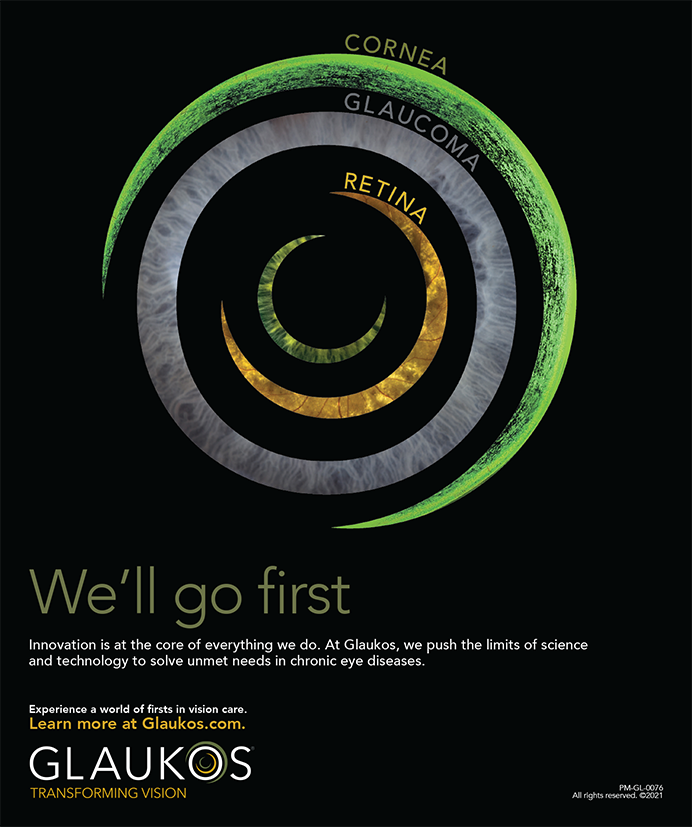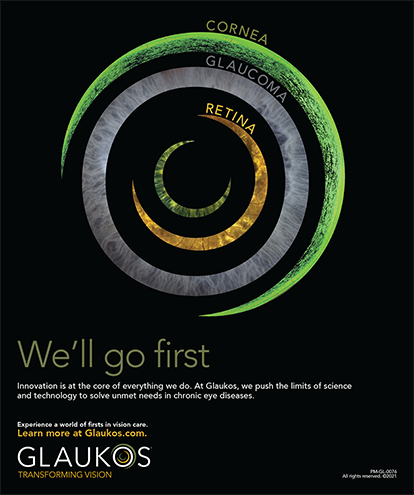Modern cataract surgery is a safe, minimally invasive procedure that produces excellent outcomes. Although it is associated with an extremely low incidence of endophthalmitis, approximately 3 million cataract surgeries performed annually in the US1,2 produce about 4,000 cases of endophthalmitis each year, with potentially devastating consequences.3
AN EFFECTIVE PROPHYLACTIC TECHNIQUEIntrinsically, it makes sense to place an antibiotic into the target tissue of the anterior chamber to eradicate or partially treat the potential bacterial inoculum that occurs at the time of surgery. The first report of successful antibiotic prophylaxis by injection into the anterior chamber was published in the 1970s.4 Since then, a number of retrospective studies have suggested that intracameral antibiotics can significantly reduce the risk of ocular infection.5 In the 1990s, for instance, two large series of cataract surgery patients and infusion fluid containing gentamicin and vancomycin were associated with no cases of endophthalmitis.6 Today, intracameral antibiotics are commonly used during cataract surgery.7
EXAMINING THE AGENTSVancomycin, Gentamicin, and Tobramycin
The most common intracameral antibiotic used today is vancomycin. Mendivil and Mendivil8 found that cataract patients who received intraoperative vancomycin (20µg/mL) had fewer positive cultures (from aspirates drawn at the end of surgery) than patients who did not receive the treatment. Earlier in vitro studies, however, questioned the efficacy of intracameral vancomycin and aminoglycosides. Gritz et al9 found that a 140-minute in vitro exposure of vancomycin (20µg/mL) and gentamicin (8µg/mL) failed to kill a variety of organisms. Furthermore, Ferro et al10 reported that anterior chamber aspirates containing vancomycin 20µg/mL and gentamicin 8µg/mL and delivered after cataract surgery were not uniformly negative when cultured 2 hours after aspiration. The findings of these studies may be due to an insufficient amount of available antibiotic owing to the rapid turnover of aqueous humor, the poor solubility of these agents, the slow kill curve of vancomycin, and the limited gram-positive spectrum of the aminoglycosides. The aminoglycosides are known to be toxic to the retina, and clinicians have documented macula infarction following the intracameral infusion of tobramycin.11 Moreover, vancomycin is not the ideal intracameral antibiotic, because it is an extremely slow bacteriocidal antibiotic, provides minimal gram-negative coverage, and is associated with cystoid macular edema after cataract surgery.12 The Centers for Disease Control and Prevention recommended that vancomycin not be used for prophylaxis.13
Fourth-Generation Fluoroquinolones Fourth-generation fluoroquinolones are concentration-dependent killers in that they must reach the minimal inhibitory concentrations (MICs) in order to be effective. Recent studies evaluating MICs have shown that this new class of agents appears to cover bacteria resistant to the second- and third-generation fluoroquinolones and is significantly more potent against gram-positive and gram-negative bacteria than previous generations.14 Some researchers have reported the possibility of concentration-independent killing against some anaerobic bacteria. Also, the fourth-generation fluoroquinolones were developed in part to resist spontaneous mutations that can cause antibiotic resistance.
The fourth-generation fluoroquinolones offer several major advantages over previously employed intracameral antibiotics. Gatifloxacin and moxifloxacin, for example, have rapid bacteriocidal action, steep kill curves,15 and high solubility, and they may be absorbed into intraocular tissue to provide a sustained release.16 These agents are also well tolerated by the cornea and retina, provide excellent gram-positive and gram-negative coverage, and can be supplemented by the topical administration of commercially available gatifloxacin (Zymar; Allergan, Inc., Irvine, CA)17 and moxifloxacin (Vigamox; Alcon Laboratories, Inc., Fort Worth, TX) to prolong their therapeutic aqueous concentration. In a rabbit model, Snyder et al18 showed that as much as 320µg of gatifloxacin in the anterior chamber is well tolerated, with no sign of corneal clouding, glaucoma, or retinal toxicity.
DOSAGEBased on aqueous production, the half-life of intracameral antibiotics is approximately 2 hours. This calculation assumes that intracameral antibiotics are neither metabolized nor actively excreted or concentrated, and thus the concentration should fall as a function of aqueous humor production and drainage. Assuming an anterior chamber volume of 400µL and an aqueous humor production rate of 2 to 3µL/min, the exponential decay equation yields a half-life value of 92 to 139 minutes. These assumptions have been empirically verified by Ferro et al19 and Mendivil and Mendivil8; both groups determined the intracameral half-life of vancomycin to be approximately 2 hours. Based on these calculations and using an MIC value of 2, 100µg of gatifloxacin placed in the anterior chamber of humans should maintain an MIC value of 2 after 10 hours without the delivery of supplemental topical antibiotic.
One human study in which I participated used intracameral gatifloxacin.20 My co-investigators and I performed routine clear corneal cataract surgery in one eye of 40 patients and then delivered an intracameral injection of gatifloxacin at the conclusion of the procedure. All patients received 100µg of the IV solution diluted in BSS into 0.1mL and injected into the middle of the anterior chamber (see the sidebar on Formulating Intracameral Gatifloxacin). In all cases, the patients tolerated the antibiotic well and displayed no signs of corneal or retinal toxicity. This intracameral dose should maintain therapeutic levels five times longer than the same concentration of vancomycin that ophthalmologists most commonly use.
The appropriate intracameral antibiotic is broad spectrum, bacteriocidal, and nontoxic; acts fast; and can be supplemented with topical medications. Injecting an antibiotic at the conclusion of surgery ensures that the dosage is both sufficient and nontoxic (toxicity can occur when the antibiotic is placed in the irrigating solution during a complex cataract extraction). At the present time, intracameral gatifloxacin appears to be safe in human eyes at a dosage of 100µg in 0.1mL.
Eric D. Donnenfeld, MD, is a partner in Ophthalmic Consultants of Long Island and is Co-Chairman of Corneal and External Disease at the Manhattan Eye, Ear, and Throat Hospital in New York. He is a consultant for Allergan, Inc., Alcon Laboratories, Inc., and Bausch & Lomb, and he performs research for Alcon Laboratories, Inc., Allergan, Inc., and Santen, Inc. He states that he holds no financial interest in any products mentioned herein. Dr. Donnenfeld may be reached at (516) 766-2519; eddoph@aol.com.
1. Javitt JC, Kendix M, Tielsch JM, et al. Geographical variation in utilization of cataract surgery. Med Care. 1995;33:90-105.2. Solomon R, Donnenfeld ED. Recent advances and future frontiers in treating age-related cataracts. JAMA. 2003;290:248-251.
3. Ciulla TA, Starr MB, Masket S. Bacterial endophthalmitis prophylaxis for cataract surgery: an evidence based update. Ophthalmology. 2002;109:13-24.
4. Peyman GA, Sathar ML, May DR. Intraocular gentamicin as intraoperative prophylaxis in South India eye camps. Br J Ophthalmol. 1977;61:260-262.
5. Gills J, Montan PG, Wejde G, et al. Prophylactic intracameral cefuroxime. Efficacy in preventing endophthalmitis after cataract surgery. J Cataract Refract Surg. 2002;28:977-981.
6. Gimbel HV, Sun R, DeBroff BM. Prophylactic intracameral antibiotics during cataract surgery: the incidence of endophthalmitis and corneal endothelial loss. Eur J Implant Refract Surg. 1994;6:280-285.
7. Leaming DV. Practice styles and preferences of ASCRS members—2000 survey. J Cataract Refract Surg. 2001;27:948-955.
8. Mendivil A, Mendivil MP. The effect of topical povidone-iodine, intraocular vancomycin, or both on aqueous humor cultures at the time of cataract surgery. Am J Ophthalmol. 2001;131:293-300.
9. Gritz DC, Cevallos AV, Smolin G, Whitcher JP. Antibiotic supplementation of intraocular irrigating solutions—an in vitro model of antibacterial action. Ophthalmology. 1996;103:1204-1209.
10. Ferro JF, de-Pablos M, Logrono MJ, et al. Postoperative contamination after using vancomycin and gentamicin during phacoemulsification. Arch Ophthalmol. 1997;115:165-170.
11. Campochiaro PA, Conway BP. Aminoglycoside toxicity—a survey of retinal specialists. Implications for ocular use. Arch Ophthalmol. 1991;109:7:946-950.
12. Blumenthal. Blumenthal M. Prophylactic intracameral vancomycin and CME. Ophthalmology. 2000;107:1616-1617.
13. The American Academy of Ophthalmology information statements page. The Prophylactic Use of Vancomycin For Intraocular Surgery. A joint statement of the American Academy of Ophthalmology and the Centers for Disease Control and Prevention. Available at: http://www.aao.org/aao/education/library/information/vancomycin.cfm. Accessed January 14, 2005.
14. Mather R, Karenchak LM, Romanowski EG, Kowalski RP. Fourth generation fluoroquinolones: new weapons in the arsenal of ophthalmic antibiotics. Am J Ophthalmol. 2002;133:4:463-466.
15. Terai K, Joo MJ, Hyon JY, et al. Comparative efficacy of topical moxifloxacin, an expanded spectrum fluoroquinolone, versus topical ofloxacin, penicillin G and tobramycin in the treatment of experimental S. pneumoniae and P. aeruginosa keratitis in rabbits. Paper presented at: The ARVO Annual Meeting; May 6, 2003; Fort Lauderdale, FL.
16. Sandoval HP, Fernandez de Castro LE, Sarraf OA, et al. Gatifloxacin 0.3% compared to ciprofloxacin 0.3% to prevent mycobacterial keratitis in an animal model. Paper presented at: The ARVO Annual Meeting; April 29, 2004; Fort Lauderdale, FL. 17. Donnenfeld E, Perry H, Greenman H, et al. Ocular tolerability of the fourth-generation fluoroquinolones gatifloxacin 0.3% and moxifloxacin 0.5%. Paper presented at: The ARVO Annual Meeting; April 29, 2004; Fort Lauderdale, FL.
18. Snyder RW, Chang M, Hare W, et al. Intraocular safety of gatifloxacin in a rabbit model. Paper presented at: The Ocular Microbiology and Immunology Group Meeting; November 15, 2003; Anaheim, CA.
19. Ferro JF, de-Pablos M, Logrono MJ, et al. Postoperative contamination after using vancomycin and gentamycin during phacoemulsification. Arch Ophthalmol. 1997;115:165-170.
20. Donnenfeld ED, Snyder RW, Kanellopolous AJ, et al. Safety of prophylactic intracameral gatifloxacin in cataract surgery. Paper presented at: The Ocular Microbiology and Immunology Group Meeting. November 15, 2003; Anaheim, CA.


